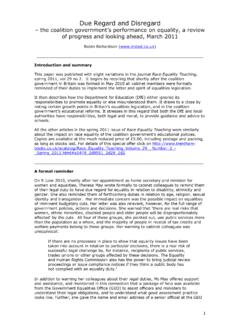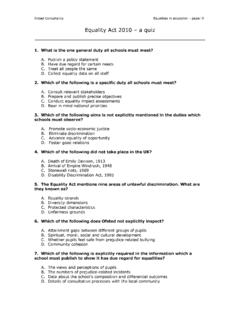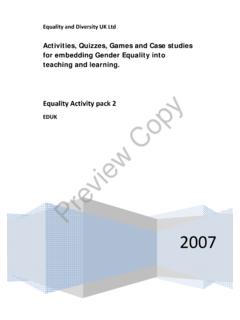Transcription of Equality objectives in schools - Insted
1 1 Equality objectives in schools smart and unsmart directions of travel Robin Richardson _____ Background and summary This paper describes the responses by schools to the specific duties required by the Equality Act 2010, particularly the duty to prepare and publish measurable objectives . It suggests that most schools do not appear to understand what the legislation requires. Also, however, it gives examples of positive responses, and itemises the principal features of good practice. Also it commends documentation published by the inspectorates in England and Wales, and by the Office of the Children s Commissioner in England. The paper draws to an end by recalling there was speculation in the media in summer 2012 that the government may be planning to repeal or revise the public sector Equality duty (PSED) introduced by the Equality Act 2010. The view expressed here is that the PSED should not be repealed, even though most schools have not yet understood what it requires, and that schools need guidance, advice and support.
2 A slightly shorter version of this paper was published in the summer 2012 issue of Race Equality Teaching, volume 30 number 3. _____ Introduction: Alice and the Cheshire Cat Would you tell me, please, says Alice plaintively but politely in her famous encounter with the Cheshire Cat, which way I ought to go from here? That depends a good deal, replies the cat, on where you want to get to. I don t much care where, says Alice. Then it doesn t matter which way you go, says the cat. So long as I get somewhere, adds Alice by way of clarification. Oh, you re sure to do that, says the cat, if you only walk long enough. The exchange is relevant to any and every consideration, for example this article, of aims and objectives . As it continues, the exchange is perhaps also relevant to many considerations of equalities. What sort of people live about here? asks Alice. In that direction, replies the cat, waving its right paw, lives a Hatter: and in that direction, waving the other paw, lives a March Hare.
3 Visit either you like: they re both mad. It would be prematurely defeatist and cynical to claim that madness lies in every which way of the equalities field. But finding and maintaining clarity and rationality in this field can be difficult and at times tiresome, for certainly there are confusions, tensions, paradoxes and apparent contradictions madness. And there s anger around too, and consequent anxiety. The field demands, to cite the two keywords in a succinct poem by Maya Angelou, both patience and passion: Seek patience and passion in equal amounts. Patience alone will not build the temple. Passion alone will destroy its walls. 2 Legal requirements Since April 2012 all schools have been required by law to publish Equality objectives , or as the term might be, Equality directions of travel. They are part and parcel of the public sector Equality duty (PSED), which is stated briefly in section 149 of the Equality Act 2010. The PSED consists of a) a general duty and b) two specific duties.
4 The purpose of the general duty, the government has said, is: to ensure that consideration of Equality issues forms part of the routine, day-to-day decision making and operational delivery of public authorities, and the purpose of the specific duties is to ensure better performance of the duty. 1 The relationship between the general duty and the specific duties was emphasised in Parliament on 11 July 2011 by the government spokesperson for equalities who explained that the purpose of the specific duties: is to help public bodies in the better performance of the Equality general duty is the key provision, which is in place and is broader than previous duties. The specific duties are designed simply to help public bodies to perform the general duty better. Publishing objectives , she said, would: ensure that public, voluntary and community sector organisations understand the key inequalities that public bodies are aspiring to tackle and to track progress against A government spokesperson provided additional clarity on the nature and purpose of Equality objectives in the House of Lords on 6 September 2011: The objectives .
5 Should clearly illustrate the real Equality improvements that the public body intends to deliver over the course of the business cycle. They should focus on the key inequalities that the body is in a position to affect, as highlighted in its published information, and identify achievable, measurable improvements. 3 This article The article is based on a study, impressionistic rather than systematic, of 40 documents from schools that were published on the internet between early April and early June 2012, focusing in particular on the specific duty to prepare and publish measurable objectives . The schools were in 28 different local authority areas, of which 11 were shires and 17 metropolitan, and their Equality documents were found through Google alerts and searches. Twenty-three were primary and 17 (including a sixth form college, a middle school and an all-through school) were secondary. Documents from seven of them, four secondary and three primary, are to be quoted here verbatim.
6 Between them, these illustrate the variety of ways in which schools have responded to the specific duty to prepare and publish objectives . Some show substantial understanding, seriousness and commitment. Others are flimsy, perfunctory and superficial. Although Equality documentation is in the public domain, as required by law, schools are described here anonymously, in order to avoid possible unfairness or embarrassment. The study is inconclusive. On the one hand, it reports that there are schools which show few if any signs of understanding what the new legislation requires of them, and few if any signs of trying to find out. At the same time, however, there is sufficient good 3practice in the world of education to show that the Equality Act specific duties are likely to be of great benefit when and where they are understood and taken Historical context Over the last two years certain newspapers have adopted the habit of referring to the Equality Act 2010 as if it is no more than the pet project or private property of a former government minister, Harriet Harman.
7 The effect is to imply there was and is no widespread support for the legislation, no thoughtful rationale for it, and no lengthy historical context of debate and deliberation about it. The legislation is portrayed as arising merely from the whims and hobby-horses of the individual politician who had responsibility for introducing it in 2008 in the House of Commons. The further implication is that the legislation can therefore be ignored with impunity and repealed without protest. However, the public sector Equality duty was not and is not the private property of a single individual, and did not arrive from nowhere in 2010. On the contrary, it is the product of more than 40 years of campaigning and arguing, and has involved many thousands of Over the decades, legal landmarks have included the following: o anti-discrimination legislation in the 1960s, followed by the Sex Discrimination Act 1975 and the Race Relations Act 1976, and the struggles, campaigns and negotiations which led to them o the strengthening of the Race Relations Act in 2000, partly inspired and influenced by the Macpherson Report of 1999, and taking into account recent legal developments in Northern Ireland, through the addition of the race Equality duty (RED)
8 To the Act, so that public authorities now had a positive duty not just to avoid discrimination but to actively eliminate it, and proactively to advance Equality of opportunity and foster good relations o adaptation of the race Equality duty in ensuing years to disability and gender, and the beginnings of legislation, following key European Community directives flowing from the Treaty of Amsterdam 1997, on age, religion and sexual identity o the bringing together of all previous anti-discrimination law into the Equality Act 2010, and the formulation within it of the public sector Equality duty (PSED) o the definition and explanation, also in the Equality Act 2010, of the key concepts of advancing Equality of opportunity and fostering good relations, and widening the circumstances in which positive action is allowed o a new duty on public authorities to have due regard for socio-economic matters in strategic decisions (though this has not been strenuously implemented and is almost certainly due to be repealed)
9 O the fact that the vast majority of the Equality Act received all-party and cross-bench support throughout its passage during 2008 10 in the House of Commons and the House of Lords o practical support and guidance for implementing the PSED provided by the specific duties to publish information and to set measurable objectives o a growing body of case law clarifying what exactly public authorities can reasonably be expected to do, and to avoid doing, to show they have due regard for 4 Case studies from schools School A is a secondary school in London. Its Equality objectives come at the end of a substantial 24-page document which sets out in great detail what the school has done to promote Equality in relation to each of the nine protected characteristics named in legislation, and which indicates the principal challenges the school continues to face. In relation to disability, ethnicity and gender the document asks five questions and answers each at length: what are we doing to eliminate discrimination?
10 What we doing to advance Equality of opportunity? what are we doing to foster good relations? what has been the impact of our policies? what do we plan to do next? In the light of these explanations and discussions, the school selects five objectives requiring special attention, as follows: o to achieve a 40% reduction in the number of fixed termed exclusions of Somali and African Caribbean pupils over 2012-13 and 2013-14. o to demonstrate through a survey of Somali and African Caribbean pupils and parents at the end of 2012-13, at least 75 per cent satisfaction with the way in which their aspirations and learning needs are met. o to double the percentage of Yr 8 girls expressing interest in pursuing a career in physics, technology or engineering by the end of 2012-13. o to achieve an increase of 10 per cent in Yr 9 girls choosing ICT as a GCSE option for 2013-14. o to achieve a 40 per cent reduction in prejudice-related behaviour, in relation to homophobia, racism and religious stereotyping over 2012-13 and 2013-14.















